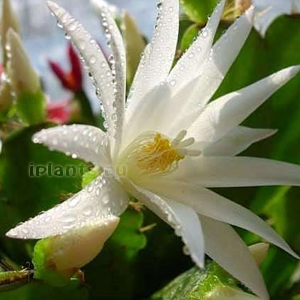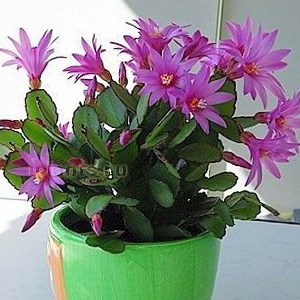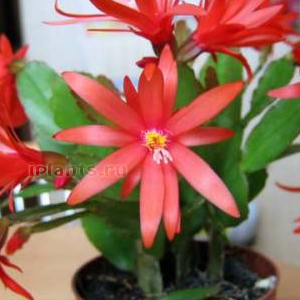Cactus family. The homeland is the tropical rainforests of South America.
Ripsalidopsis are often confused with Schlumberger (or Decembrist). But in fact, these are two different plants of the genus Hatiora Hatiora, the main difference of which, as always, is determined by the structure of the flower. Ripsalidopsis have a radially symmetrical flower corolla structure - in schlumberger, the flower corolla is beveled. In addition, Schlumbergers bloom for Christmas, from which the Decembrists got their name. Ripsalidopsis bloom in spring. Accordingly, the rest period for the schlumberger is in February - March, for the ripsalidopsis from October to January.
- Gartner's ripsalidopsis Rhipsalidopsis gaertneri (found as Schlumberger's gaertneri) is a large plant with leaf-like stem segments about 6-7 cm, having a wavy edge. The flower is bell-shaped petals pointed at the end, about 4 cm in diameter. The flowers are orange-red.
- Ripsalidopsis rosea Rhipsalidopsis rosea is more compact than the previous species, segments of the stem 4-5 cm long, with a slightly festooned edge. With delicate pink flowers.
Care for Ripsalidopsis
Temperature: Ideal conditions for growth and flowering are a little cool, about 18-22 ° C in the warm season, from October to January you need to provide a period of rest at a temperature of 15-17 ° C. Although ripsalidopsis live perfectly in ordinary home conditions all year round, a dormant period is needed, first of all, with an acute lack of light in winter and high temperature (from batteries), growth continues, but the shoots are frail, elongated. Do not forget that this is a forest, but a cactus.
Lighting: Light place, light partial shade in summer, but always shading from direct sunlight. It grows well on the north window. In winter, very good lighting, south or southwest window, without shading.
Watering: With the advent of buds, they water abundantly enough until the end of flowering - the earth should not remain dry for long. With the end of flowering, a decrease in temperature, lack of visible growth - watering is reduced, plants are well dried. Since September, the plant goes into a dormant stage, with a decrease in watering temperature, limited, watered occasionally, preventing the soil from only drying completely into dust.
Fertilizer: Fed from March to June with special fertilizers for cacti, every two weeks. It is impossible to use organic fertilizers for ripsalidopsis, as well as for other cacti.
Humidity: Spraying and occasional warm showers benefit forest cacti. It is especially good to spray in the morning, on hot summer days, but the moisture from the leaves should dry out before the sun's rays hit them.
Transplantation: Transplanted after flowering or in spring at the beginning of growth. The capacity for landing is quite spacious in width, but shallow. Forest cacti prefer soil with a slightly acidic pH reaction of 5.5-6. The mixture is the 1 part of the turf, the 2 part of the sheet, the 1 part of the small gravel, a little brick crumb. Make a 2cm drain on the bottom of the pot.
Reproduction: Seeds and cuttings, which are planted several pieces in one pot. Cuttings having 2-3 segments are dried for 2 days and rooted in moist substrate of leaf earth and sand in equal parts. Cuttings cannot be buried in the ground - it is enough that the lower part of the segment will simply touch the soil.
Seeds retain their germination for several years. They are sown in wide plates with a mixture of sheet earth in half with sand. Grown seedlings are planted in pots of several pieces to make the bushes look more beautiful and bushy.



